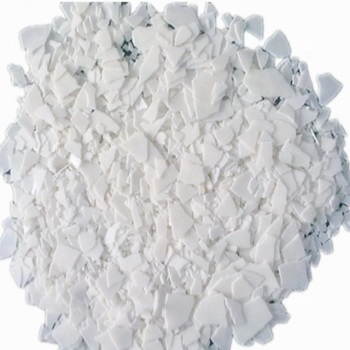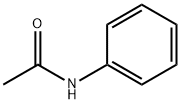아세트아닐리드
|
|
아세트아닐리드 속성
- 녹는점
- 113-115 °C(lit.)
- 끓는 점
- 304 °C(lit.)
- 밀도
- 1,121 g/cm3
- 증기 밀도
- 4.65 (vs air)
- 증기압
- 1 mm Hg ( 114 °C)
- 굴절률
- 1.5700 (estimate)
- 인화점
- 173 °C
- 저장 조건
- Store below +30°C.
- 용해도
- 물에 약간 용해됨; 에탄올과 아세톤에 매우 잘 녹습니다. 에틸 에테르에 용해됩니다.
- 물리적 상태
- 가루
- 산도 계수 (pKa)
- 0.5(at 25℃)
- 색상
- 미색에서 베이지색, 회청색까지
- 수소이온지수(pH)
- 5-7 (10g/l, H2O, 25℃)
- 수용성
- 5 g/L (25 ºC)
- Merck
- 14,50
- BRN
- 606468
- Dielectric constant
- 2.9(22.0℃)
- 안정성
- 안정적인. 타기 쉬운. 강한 산화제, 부식제, 알칼리와 호환되지 않습니다.
- LogP
- 1.160
- CAS 데이터베이스
- 103-84-4(CAS DataBase Reference)
안전
- 위험 및 안전 성명
- 위험 및 사전주의 사항 (GHS)
| 위험품 표기 | Xn | ||
|---|---|---|---|
| 위험 카페고리 넘버 | 22-36/37/38 | ||
| 안전지침서 | 22-26-36 | ||
| WGK 독일 | 1 | ||
| RTECS 번호 | AD7350000 | ||
| 자연 발화 온도 | 540 °C | ||
| TSCA | Yes | ||
| HS 번호 | 29242995 | ||
| 유해 물질 데이터 | 103-84-4(Hazardous Substances Data) | ||
| 독성 | LD50 intragastric in rats: 800 mg/kg (Smith, Hambourger) | ||
| 기존화학 물질 | KE-28264 |
아세트아닐리드 C화학적 특성, 용도, 생산
화학적 성질
Acetanilide, also known as Nphenylacetamide, acetanil, or acetanilide is a white to gray solid with molecular formula CH3CONHC6H5. It is an odorless colorless, glossy, crystalline powder or flakes. Acetanilide was the first aniline derivative found to possess analgesic as well as antipyretic properties and was quickly introduced into medical practice (Weast, 1981; Gnanasambandan et al., 2014). Later, it was established that in the human body it is mostly metabolized to paracetamol, this compound being responsible for the analgesic and antipyretic properties of acetanilide (Bertolini et al., 2006; Gnanasambandan et al., 2014). In addition, it was discovered that it has unacceptable toxic effects, so that acetanilide is no longer used as a drug.
Acetanilide is mainly used as an intermediates in the synthesis of pharmaceuticals and dyes, as an additive for hydrogen peroxide and cellulose ester varnishes, and as a plasticizer in polymer industry as well as accelerator in the rubber industry.
물리적 성질
White glossy flake crystal or white crystalline powder. Slightly soluble in cold water, soluble in hot water, methanol, ethanol, ether, chloroform, acetone, glycerol and benzene.역사
The department of internal medicine at the University of Strassburg in the 1880s was noted for its investigations into intestinal worms. Adolf Kussmaul, the director, asked two young assistants, Arnold Cahn and Paul Hepp, to treat patients with naphthalene as it had been used elsewhere as an internal antiseptic. The young doctors were disappointed with the initial results, but Hepp persevered with the naphthalene treatment in a patient suffering from a variety of complaints besides worms. Surprisingly, the fever chart revealed a pronounced antipyretic effect from this treatment. This had not been observed before, but further investigation revealed that Hepp had wrongly been supplied by Kopp’s Pharmacy in Strassburg with acetanilide instead of naphthalene! Cahn and Hepp lost no time in publishing a report on their discovery of a new antipyretic.For many years after its discovery in 1886, Acetanilide was used as an alternative to aspirin (i.e. acetyl salicylate) - an analgesic (painkiller) and antipyretic (fever reducing) drug to relieve e.g. headache, menstrual pain, and rheumatic pain. Under the name “Acetanilide” it formerly appeared in the formula of a number of patent medicines and over the counter drugs. In 1948, Julius Axelrod and Bernard Brodie discovered that Acetanilide is much more toxic in these applications than other drugs, causing methemoglobinemia and ultimately causing damage to the liver and kidneys. Thus, Acetanilide has largely been replaced by less toxic drugs, in particular acetaminophen (i.e. paracetamol), which is a metabolite of Acetanilide and whose use Axelrod and Brodie suggested in the same study.
주요 응용
Acetanilide is used as an inhibitor of hydrogen peroxide decomposition and to stabilize cellulose ester varnishes. It is also used in the intermediation of rubber accelerator synthesis, dyes and dye intermediate synthesis, and camphor synthesis. Acetanilide is used for the production of 4-acetamidobenzenesulfonyl chloride, a key intermediate for the manufacture of the sulfa drugs. It is also a precursor in the synthesis of penicillin and other pharmaceuticals. In the 19th century acetanilide was one of a large number of compounds used as experimental photographic developers.Acetanilide is used as a EOF (electroosmotic flow) marker in the studies of affinity capillary electrophoresis for drug–protein binding.
Acetanilide undergoes palladium-catalyzed cross-coupling reaction to form ortho-acylacetanilide.
제조 방법
Acetanilide is prepared from aniline by acetylating it with acetic anhydride in presence of glacial acetic acid. Aniline reacts with acetic anhydride to form Acetanilide by nucleophilic substitution reaction and the reaction is called acetylation.
In a 100 ml round bottom flask fitted with a reflux condensor place 5ml of aniline and 10 ml of 1:1 acetic acid and acetic anhydride mixture (5ml acetic acid and 5 ml acetic anhydride). Heat the mixture gently under reflux for 15-20 minutes on oil bath and then pour the contents while still hot with stirring into a 200ml beaker containing 100ml ice cold water. Stir the mixture vigorously to hydrolyse the excess acetic anhydride. After all the acetanilide has precipitated, collct it on buchner funnel and wash with cold water. Recrystallise the crude product from boiling water. If the product is excessively coloured add a pinch of animal charcoal to hot water and filter hot through glass wool/ cotton plug. Pure colourless crystals of acetanilide melts at 114°C (5-5.5g).
정의
ChEBI: Acetanilide is a member of the class of acetamides that is acetamide in which one of the hydrogens attached to the nitrogen is substituted by a phenyl group. It has a role as an analgesic. It is a member of acetamides and an anilide. It is functionally related to an acetic acid.World Health Organization (WHO)
Acetanilide, a para-aminophenol derivative with analgesic, antipyretic and weak antiinflammatory activity, was introduced into medicine in 1886. It subsequently proved to be excessively myelosuppressive and has been superseded by safer alternatives.일반 설명
Acetanilide is a white to gray solid. (NTP, 1992)공기와 물의 반응
Acetanilide is sensitive to prolonged exposure to air . Water insoluble.반응 프로필
Acetanilide is an amide. Flammable gases are formed by the reaction of organic amides with strong reducing agents. Amides are very weak bases (weaker than water). Imides are less basic yet and in fact react with strong bases to form salts. That is, they can react as acids. Mixing amides with dehydrating agents such as P2O5 or SOCl2 generates the corresponding nitrile. The combustion of these compounds generates mixed oxides of nitrogen (NOx).화재위험
Acetanilide is combustible.Safety Profile
A human poison by an unspecified route. Poison by ingestion and intravenous routes. Moderately toxic by intraperitoneal route. Human systemic effects by ingestion: hallucinations and dstorted perceptions, sleepiness, constipation, cyanosis, respiratory stimulation, hdney damage, me themoglobinemiacarboxyhemoglobinemia, and decreased body temperature. Mutation data reported. When heated to decomposition it emits toxic fumes of NOx,. Combustible when exposed to heat or flame. See also ANILINE.잠재적 노출
This amide compound is used in rubber industry as accelerator, in plastics industry as cellulose ester stabilizer, in pharmaceutical manufacture, stabilizer for hydrogen peroxide, azo dye manufacture운송 방법
UN2811 Toxic solids, organic, n.o.s., Hazard Class: 6.1; Labels: 6.1-Poisonous materials, Technical Name Required.Purification Methods
Recrystallise acetanilide from water, aqueous EtOH, *benzene or toluene. [Beilstein 12 IV 373.]비 호환성
Dust may form explosive mixture with air. Incompatible with oxidizers (chlorates, nitrates, peroxides, permanganates, perchlorates, chlorine, bromine, fluorine, etc.); contact may cause fires or explosions. Keep away from alkaline materials, strong bases, strong acids, oxoacids, epoxides, alkyl nitrates, alkalis (liberate aniline), chloral hydrate, phenols, ferric salts폐기물 처리
Add to flammable solvents (alcohol or benzene) and incinerate. Oxides of nitrogenmay be scrubbed from combustion gases with alkaline solution아세트아닐리드 준비 용품 및 원자재
원자재
준비 용품
설파살라진
설파퀴녹살린
Disperse Blue 301
Asulam
Doxycycline hydrochloride
3-Ethoxyaniline
METHYL 4-(4-(BIS(2-HYDROXYETHYL)AMINO)PHENYL)BUTYRATE
설파닐아미드
2-(4-아미노페닐술포닐)에틸 황산
염료 옐로우 1
p-아미노아세트아닐리드
p-아미노아세트페논
4-아미노-3-나이트로페놀
4-(4-Aminophenyl)butyric acid
METHYL 4-(4-(BIS(2-CHLOROETHYL)AMINO)PHENYL)BUTYRATE
4,4′-(9-플루오레닐아이딘)다이아닐린
2-MORPHOLIN-4-YL-1,3-THIAZOL-4(5H)-ONE
4-(4-IODO-PHENYL)-4-OXO-BUTYRIC ACID
2-메틸-4-메톡시디페닐아민
아세트아닐리드 공급 업체
글로벌( 364)공급 업체
| 공급자 | 전화 | 이메일 | 국가 | 제품 수 | 이점 |
|---|---|---|---|---|---|
| Hebei Mojin Biotechnology Co., Ltd | +8613288715578 |
sales@hbmojin.com | China | 12456 | 58 |
| Springchem New Material Technology Co.,Limited | +86-021-62885108 +8613917661608 |
info@spring-chem.com | China | 2068 | 57 |
| Shanghai Daken Advanced Materials Co.,Ltd | +86-371-66670886 |
info@dakenam.com | China | 15928 | 58 |
| Henan Tianfu Chemical Co.,Ltd. | +86-0371-55170693 +86-19937530512 |
info@tianfuchem.com | China | 21691 | 55 |
| Hefei TNJ Chemical Industry Co.,Ltd. | +86-0551-65418679 +86-18949832763 |
info@tnjchem.com | China | 2989 | 55 |
| career henan chemical co | +86-0371-86658258 |
sales@coreychem.com | China | 29914 | 58 |
| SHANDONG ZHI SHANG CHEMICAL CO.LTD | +86 18953170293 |
sales@sdzschem.com | China | 2931 | 58 |
| Hubei Jusheng Technology Co.,Ltd. | 18871490254 |
linda@hubeijusheng.com | CHINA | 28180 | 58 |
| Jinan Finer Chemical Co., Ltd | +86-531-88989536 +86-15508631887 |
sales@finerchem.com | China | 2967 | 58 |
| Hebei Guanlang Biotechnology Co., Ltd. | +86-19930503282 |
alice@crovellbio.com | China | 8823 | 58 |







